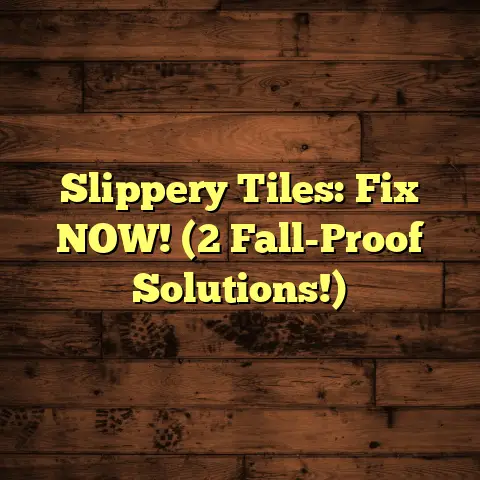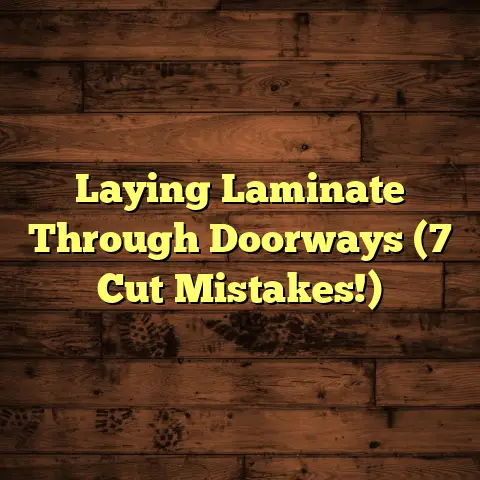Castile Soap Recipes For Hardwood And Tile Floors?
Allergies, right? They’re practically a modern epidemic. Dust, pet dander, pollen – the usual suspects are everywhere.
But what about your cleaning products? Did you know those seemingly innocent bottles under your sink could be contributing to your sniffles and sneezes?
Many traditional cleaners are packed with harsh chemicals that can really irritate sensitive systems.
As a flooring contractor, I’ve seen firsthand how these chemicals can affect not only people’s health but also the longevity of their floors.
That’s why I’m a huge advocate for natural cleaning alternatives, and Castile soap is one of my favorites.
It’s gentle, effective, and won’t leave your home smelling like a chemical factory.
In this article, I’m going to share my go-to Castile soap recipes for both hardwood and tile floors.
These recipes are tailored for different cleaning needs, from everyday maintenance to tackling stubborn stains.
I am hoping to help you create a healthier, happier home, one clean floor at a time.
Section 1: Understanding Castile Soap
Okay, let’s dive into the basics. What exactly is Castile soap?
Simply put, it’s a vegetable-based soap, traditionally made from olive oil.
The name “Castile” comes from the Castile region of Spain, where it originated.
Unlike many commercial soaps that contain synthetic detergents and animal fats, Castile soap is all-natural and biodegradable.
This makes it a fantastic choice for anyone looking to reduce their environmental impact.
But the benefits don’t stop there. Castile soap is incredibly effective at cutting through grime and dirt without leaving behind any harmful residues.
I’ve used it on countless flooring projects, and I’m always impressed by its cleaning power.
Plus, it’s incredibly versatile. You can use it for everything from washing your face and body to doing laundry and cleaning your entire house.
I personally love using it as a hand soap in my workshop.
It gets rid of grease and grime without drying out my skin.
Section 2: Why Choose Natural Cleaning Solutions for Allergy Prevention
Let’s talk about allergies and cleaning products. It’s a connection that often gets overlooked.
According to the Asthma and Allergy Foundation of America, exposure to certain chemicals in cleaning products can trigger allergic reactions and asthma symptoms.
Think about it: you’re mopping your floors, and those chemicals are released into the air, where you and your family breathe them in.
Not ideal, right?
Maintaining a clean living environment is crucial for allergy sufferers. Dust, mold, and pet dander can all accumulate on floors, triggering allergic reactions.
While regular cleaning is essential, the type of cleaner you use matters just as much.
Let’s compare the ingredients of a conventional floor cleaner with those of Castile soap.
Conventional cleaners often contain synthetic fragrances, dyes, and preservatives, all of which can be irritants.
Castile soap, on the other hand, contains just a few simple ingredients: water, vegetable oil (usually olive oil), and lye (which is neutralized during the soap-making process).
Here’s a quick comparison table:
| Feature | Conventional Floor Cleaner | Castile Soap |
|---|---|---|
| Ingredients | Synthetic detergents, fragrances, dyes, preservatives | Water, vegetable oil, lye (neutralized) |
| Allergen Potential | High | Low |
| Environmental Impact | High (non-biodegradable) | Low (biodegradable) |
| Residue | Can leave a chemical residue | Minimal to no residue |
I’ve seen firsthand the positive impact that switching to natural cleaning solutions can have on people’s health.
Clients who previously struggled with allergies and sensitivities often report a significant improvement in their symptoms after making the switch.
Section 3: Preparation and Safety Considerations
Alright, you’re convinced. Let’s get down to the nitty-gritty of preparing Castile soap solutions for cleaning.
First, you’ll need a few basic tools:
- Mop: A microfiber mop is ideal for both hardwood and tile floors.
- Bucket: For mixing your cleaning solution.
- Spray bottle: For targeted stain removal or applying cleaner to smaller areas.
- Gloves: To protect your hands, especially when dealing with concentrated solutions or grout cleaning.
Now, here’s a crucial step: always test your cleaning solution on a small, inconspicuous area of your flooring before applying it to the entire surface.
This will help you ensure compatibility and prevent any potential damage or discoloration.
I usually test in a closet or under a piece of furniture.
Safety is also paramount. While Castile soap is gentle, it’s still important to take precautions.
Wear gloves to protect your skin, and ensure adequate ventilation during cleaning.
Open windows or turn on a fan to circulate air.
Never mix Castile soap with other cleaning products, especially bleach.
This can create harmful fumes.
Section 4: Castile Soap Recipes for Hardwood Floors
Now for the fun part: the recipes! Let’s start with hardwood floors.
I’ve used these recipes on a variety of hardwood floors, from oak to maple to bamboo, with great results.
1. Basic Castile Soap Floor Cleaner
This is my go-to recipe for everyday cleaning. It’s simple, effective, and won’t damage your hardwood floors.
- Ingredients:
- 1/4 cup Castile soap
- 1 gallon warm water
- Instructions:
- Combine the Castile soap and warm water in a bucket.
- Dip your mop into the solution, wring it out thoroughly, and mop your floors.
- Rinse your mop frequently in clean water.
- Allow the floors to air dry.
2. Essential Oil Infused Cleaner
For added antibacterial properties and a pleasant scent, try adding a few drops of essential oil to your cleaning solution.
- Ingredients:
- 1/4 cup Castile soap
- 1 gallon warm water
- 10-15 drops of your favorite essential oil (lavender, tea tree, and lemon are all good choices)
- Instructions:
- Combine the Castile soap, warm water, and essential oil in a bucket.
- Dip your mop into the solution, wring it out thoroughly, and mop your floors.
- Rinse your mop frequently in clean water.
- Allow the floors to air dry.
3. Stain Remover Formula
Tough stains on hardwood floors can be a real headache. This recipe combines the cleaning power of Castile soap with the stain-removing properties of vinegar or baking soda.
- Ingredients:
- 1 tablespoon Castile soap
- 1 cup warm water
- 1 tablespoon white vinegar or baking soda
- Instructions:
- Combine the Castile soap, warm water, and vinegar or baking soda in a spray bottle.
- Shake well to mix.
- Spray the solution directly onto the stain.
- Let it sit for a few minutes.
- Gently scrub the stain with a soft cloth or sponge.
- Rinse the area with clean water and dry thoroughly.
4. Wood Polish Recipe
To nourish and protect your hardwood floors, try this wood polish recipe. It combines Castile soap with natural oils to keep your floors looking their best.
- Ingredients:
- 1/4 cup Castile soap
- 1 gallon warm water
- 1 tablespoon olive oil or jojoba oil
- Instructions:
- Combine the Castile soap, warm water, and oil in a bucket.
- Dip your mop into the solution, wring it out thoroughly, and mop your floors.
- Rinse your mop frequently in clean water.
- Allow the floors to air dry.
- After the floors are dry, buff them with a clean, dry cloth to bring out the shine.
Important Note: When using any of these recipes on hardwood floors, it’s crucial to wring out your mop thoroughly.
Excess water can damage hardwood floors, leading to warping and discoloration.
I always recommend using a microfiber mop, as it’s more absorbent and less likely to leave behind excess water.
Section 5: Castile Soap Recipes for Tile Floors
Now let’s move on to tile floors. Tile is generally more durable than hardwood, but it still requires regular cleaning to maintain its appearance.
These recipes are designed to tackle dirt, grime, and even stubborn grout stains.
1. Standard Tile Cleaner
This is a basic mix of Castile soap and water that’s perfect for regular cleaning of tile floors.
- Ingredients:
- 1/4 cup Castile soap
- 1 gallon warm water
- Instructions:
- Combine the Castile soap and warm water in a bucket.
- Dip your mop into the solution, wring it out thoroughly, and mop your floors.
- Rinse your mop frequently in clean water.
- Allow the floors to air dry.
2. Grout Cleaner Recipe
Grout lines can be a breeding ground for dirt and grime. This recipe combines the cleaning power of Castile soap with the abrasive properties of baking soda to deep clean grout lines.
- Ingredients:
- 1/4 cup Castile soap
- 1/2 cup baking soda
- Warm water
- Instructions:
- Make a paste by mixing Castile soap and baking soda, adding little warm water.
- Apply the paste to the grout lines.
- Let it sit for 5-10 minutes.
- Scrub the grout lines with a stiff-bristled brush.
- Rinse the area with clean water and dry thoroughly.
3. Disinfecting Tile Cleaner
For a disinfecting solution, combine Castile soap with vinegar and essential oils. Vinegar is a natural disinfectant, and essential oils can add extra antibacterial properties.
- Ingredients:
- 1/4 cup Castile soap
- 1/2 cup white vinegar
- 1 gallon warm water
- 10-15 drops of tea tree oil or eucalyptus oil
- Instructions:
- Combine the Castile soap, vinegar, warm water, and essential oils in a bucket.
- Dip your mop into the solution, wring it out thoroughly, and mop your floors.
- Rinse your mop frequently in clean water.
- Allow the floors to air dry.
4. Mop Solution for Tile Floors
This recipe is designed for use in mop buckets for larger areas of tile flooring.
- Ingredients:
- 1/4 cup Castile soap
- 1 gallon warm water
- Optional: 5-10 drops of your favorite essential oil
- Instructions:
- Combine the Castile soap, warm water, and essential oil (if using) in a mop bucket.
- Dip your mop into the solution, wring it out thoroughly, and mop your floors.
- Rinse your mop frequently in clean water.
- Allow the floors to air dry.
Pro Tip: For heavily soiled tile floors, I recommend pre-treating the area with a solution of Castile soap and water before mopping.
Simply spray the solution onto the floor, let it sit for a few minutes, and then mop as usual.
This will help loosen dirt and grime, making it easier to remove.
Section 6: Tips for Maintaining Clean Floors with Castile Soap
Maintaining clean floors with Castile soap is easy, but there are a few tips I’d like to share to help you get the best results.
-
Frequency of Cleaning: How often you clean your floors will depend on your lifestyle and the amount of traffic they receive.
In general, I recommend mopping hardwood floors once a week and tile floors every 1-2 weeks.
If you have pets or young children, you may need to clean more frequently. * Regular Dusting and Sweeping: Before mopping, it’s essential to remove loose dirt and debris from your floors.
Dusting and sweeping will prevent scratches and damage to your floors. I recommend using a microfiber dust mop or a soft-bristled broom. * Dealing with Spills and Stains Promptly: The sooner you address spills and stains, the easier they will be to remove.
Blot up spills immediately with a clean cloth or paper towel. For stubborn stains, use the stain remover formula I shared earlier. * Proper Mop Technique: When mopping, always wring out your mop thoroughly to prevent excess water from damaging your floors.
Use a figure-eight motion to ensure that you’re covering the entire surface. Rinse your mop frequently in clean water to avoid spreading dirt and grime. * Choosing the Right Castile Soap: Not all Castile soaps are created equal. Look for a pure Castile soap that’s made with olive oil or other vegetable oils.
Avoid soaps that contain synthetic fragrances, dyes, or other additives. I personally recommend Dr. Bronner’s Castile Soap.
Conclusion
So, there you have it: my ultimate guide to using Castile soap for cleaning hardwood and tile floors.
As I’ve shown, Castile soap is a natural, effective, and allergy-friendly alternative to conventional cleaning products.
By using the recipes and tips I’ve shared, you can create a healthier, happier home for yourself and your family.
The ease and effectiveness of these recipes make it simple to embrace natural cleaning solutions.
Not only are you reducing your exposure to harsh chemicals, but you’re also doing your part to protect the environment.
I encourage you to try out these recipes and see the difference for yourself.
Share your experiences with me and other natural cleaning enthusiasts. Let’s build a community of people who are passionate about creating healthy, sustainable homes.
What are you waiting for? Grab a bottle of Castile soap and get cleaning! Your floors (and your allergies) will thank you.





